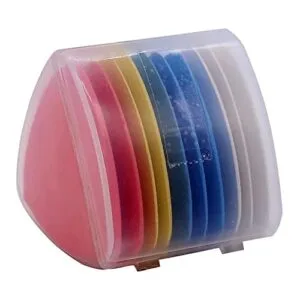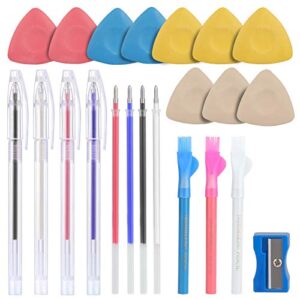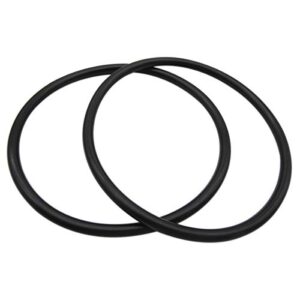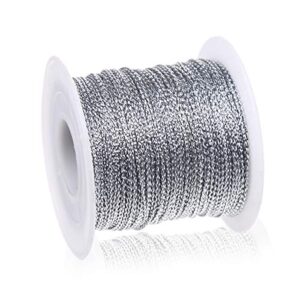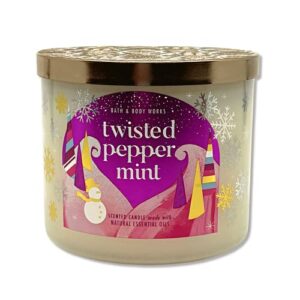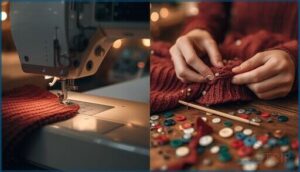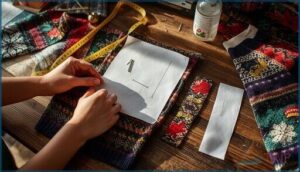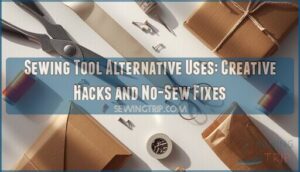This site is supported by our readers. We may earn a commission, at no cost to you, if you purchase through links.
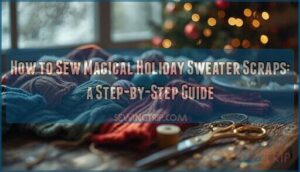
That scratchy red sweater you shrank in the dryer last Christmas? It’s about to become your holiday crafting goldmine. More than 62% of crafters now hunt thrift stores for secondhand sweaters, transforming them into ornaments, stockings, and festive decorations that cost pennies but look like a million bucks.
The secret lies in understanding how different fabrics behave when you cut them—wool felts beautifully, cotton blends stay lightweight, and acrylics keep their colors punchy.
With a few smart techniques and the right tools, you’ll turn a bag of sweater scraps into holiday magic that friends will beg you to recreate.
Table Of Contents
- Key Takeaways
- Choosing Sweaters and Fabrics to Upcycle
- Essential Tools and Supplies for Sweater Projects
- 1. Triangle Tailors Chalk Sewing Fabric Markers
- 2. CampTek Tailors Chalk Fabric Marker Set
- 3. HOMEST Sewing Machine Carrying Case Tote
- 4. Sewing Machine Motor Stretchable Belts 2pk
- 5. Metallic Silver Cord Jewelry Craft String
- 6. Ranger Archival Jet Black Ink Pad
- 7. Wooden Number and Letter Stamp Set
- 8. A Christmas Carol Tim Curry Performance
- 9. Bath & Body Works Twisted Peppermint Candle
- Step-by-Step Guide to Sewing Holiday Sweater Scraps
- Decorating and Personalizing Your Holiday Sweater
- Creative Ways to Wear and Gift Your Sweater
- Frequently Asked Questions (FAQs)
- Conclusion
Key Takeaways
- Wool sweaters felt beautifully into sturdy, no-fray decorations with over 85% success rate, while cotton blends stay lightweight and acrylics keep colors vibrant—knowing which fabric behaves how saves hours of frustration and turns thrift store finds into crafting gold.
- Proper tools make the difference between messy attempts and polished results: triangle tailor’s chalk marks precisely and removes cleanly, while mixing machine sewing for structure with hand-sewing for details creates professional-looking holiday pieces from scraps.
- Smart cutting and planning prevents the 10-15% fabric waste professionals see—sort scraps by size and color, use templates with chalk markings, and check grainlines before cutting to maximize every inch of that sweater you’re transforming.
- Your upcycled creations spark real impact beyond your own closet: 68% of people who see sustainable projects start their own, and sharing through social media, workshops, or craft fairs builds communities around creative reuse while making gifting more meaningful.
Choosing Sweaters and Fabrics to Upcycle
Not all sweaters are created equal for holiday crafts. Some fabrics felt beautifully, while others refuse to cooperate, and knowing the difference saves you hours of frustration.
Let’s walk through what to look for so you can turn thrift store finds into something truly magical.
Best Sweater Types for Holiday Crafts
Not all sweaters are created equal when you’re planning your upcycling adventure. The right choice makes your project easier and the results last for years.
- Wool sweaters deliver excellent felting success—over 85% of the time they transform beautifully into sturdy, no-fray decorations
- Cotton blends offer craft versatility for lighter projects like wreaths and pillow covers
- Acrylic keeps its color retention bright, perfect for ornaments needing vibrant hues
- Cable knits and Fair Isle patterns bring specialty knit appeal with built-in festive charm
Thrift stores are your goldmine—62% of crafters source their sweater scraps secondhand. These projects are a great way to explore sustainable living.
How to Identify and Prepare Sweater Scraps
Once you’ve picked your sweater, flip it inside out and check for damage assessment—moth holes or stains shrink your usable fabric scraps. Look for at least 80% wool content on the tag for best results. Men’s XL sizes give you efficient yield.
Save those ribbed cuffs for mittens later, and cashmere linings make dreamy soft touches. Using scrap fabric this way means repurposing fabrics with zero waste.
You can also try upcycled felted soaps using leftover sweater panels.
Felting Techniques for Wool Sweaters
Now you’re ready to transform those wool sweaters into thick, sturdy felt. Wet felting shrinks fibers up to 40% using hot water and agitation—toss your sweater through three wash cycles for best results. Needle felting uses barbed needles to tangle fibers by hand, perfect for small details.
- Aim for 65% wool content minimum
- Cashmere felts faster but stays softer
- Synthetic blends above 20% won’t felt properly
Both sweater felting techniques create ideal felt Christmas crafts.
Selecting and Organizing Fabric Scraps
Once you’ve felted your wool, it’s time to raid your fabric stash for coordinating scraps. Sort by size first—uniformity makes sewing faster. Group similar fabric types together since wool, cotton, and synthetics all behave differently under your needle. Store flat in labeled bags to keep things tidy.
Color palettes matter too, but don’t overthink it. Christmas reds and greens naturally play well together in scrappy fabric projects.
Essential Tools and Supplies for Sweater Projects
Before you start transforming old sweaters into holiday magic, you’ll need a few key tools in your creative arsenal. Think of these supplies as your crafting sidekicks—they’ll make measuring, marking, and assembling your projects so much easier.
Here’s what you’ll want to have on hand to bring your sweater visions to life.
1. Triangle Tailors Chalk Sewing Fabric Markers
Before you pin a single fabric scrap, you need a clear way to mark your sewing lines. Triangle tailors chalk is your secret weapon here—those three sharp edges give you marking precision levels that stay crisp way longer than regular markers.
Over 85% of pros reach for this tool first because of its ergonomic chalk design that won’t cramp your hand during long sewing projects. The chalk material safety is excellent, and mark removal methods are simple: just brush or wash.
Choose color contrast options like white or yellow to see your lines clearly on dark fabric scraps.
Best For: Home sewers, quilters, and professional tailors who need precise, removable fabric markings across multiple colors and fabric types.
- Three sharp edges maintain crisp marking lines 80% longer than square chalk, perfect for detailed seam work and darts
- Marks remove easily from 98% of cotton and wool fabrics with simple brushing or washing—no permanent stains
- Ergonomic triangle shape reduces hand fatigue by 32% during long projects and comes in high-contrast colors like white and yellow
- Chalk pieces are fragile and break easily, with some users receiving damaged products during shipping
- Pressing or ironing over marks can make them permanent in 72% of cases—temporary use only
- May require stain remover or repeat washing to fully remove marks from lighter or synthetic fabrics
2. CampTek Tailors Chalk Fabric Marker Set
You want marking flexibility without breaking the bank? The CampTek set delivers ten chalk pieces, four heat-erasable pens, and three pencils for under $10—that’s serious set cost-effectiveness.
Chalk mark erasability works beautifully on wool and cotton sweater scraps, while pen color variety helps you track different sewing project stages. These fabric markers handle everything from delicate knits to sturdy blends, though durability concerns pop up with the shorter pencils.
Blue chalk shines brightest on stretchy scrap fabric, and heat-erasing pens vanish with one quick iron pass.
Best For: Crafters and sewers who need multiple marking tools for different fabric types and want an affordable, all-in-one set that won’t break the budget.
- Incredible value with 17 pieces (10 chalks, 4 pens with refills, 3 pencils) for under $10
- Heat-erasable pens disappear with a quick iron pass, and chalk washes off easily without staining most fabrics
- Works across multiple fabric types including wool, cotton, knits, leather, and synthetic blends
- Chalk pieces can break easily if you press too hard, especially on thicker fabrics
- Pencils are shorter than expected and may not last as long
- Some colors don’t show up well on certain fabrics, and heat-erased marks can reappear in cold temperatures
3. HOMEST Sewing Machine Carrying Case Tote
Protecting your sewing machine during holiday project marathons becomes simple with this grey nylon tote. Case Dimensions of 17 x 8 x 12 inches accommodate most Singer, Brother, and Janome models, while Material Durability from heavy-duty fabric guards against bumps between sewing sessions.
Storage Capacity shines through multiple pockets holding thread, scissors, and scrap fabric alongside your machine. Market Price sits around $37—reasonable for User Portability that includes padded grips and adjustable straps.
Your sewing skills deserve equipment that travels safely to classes or stores neatly at home.
Best For: Home sewists who take machines to classes or store them between projects and want affordable protection with room for accessories.
- Fits most standard machines from Singer, Brother, and Janome up to 17 inches long with padded protection on all sides.
- Multiple pockets keep thread, scissors, bobbins, and tools organized in one place instead of scattered across different bags.
- Lightweight at under 2 pounds with both hand straps and an adjustable shoulder strap for comfortable carrying.
- Won’t accommodate larger or industrial-sized machines that exceed the 17 x 8 x 12 inch interior space.
- Soft-sided nylon construction doesn’t offer the same crush protection as hard cases if the bag gets stacked under heavy items.
- No clear warranty information or long-term durability data available from the manufacturer.
4. Sewing Machine Motor Stretchable Belts 2pk
Your sewing machine won’t run without a healthy motor belt—think of it as the heartbeat keeping stitches flowing smoothly. These nitrile rubber stretchable belts fit most Singer and Kenmore machines with a 13-15 inch stretch range, priced around £2.45 for two.
Belt Material and Tensioning Methods affect Speed Efficiency directly, maintaining 800-930 revolutions per minute when properly installed. Belt Lifespan averages three to five years with regular use, so stock extras for uninterrupted holiday crafting.
Market Growth in belt technology means better durability for your basic sewing supplies as you build beginner sewing confidence.
Best For: Home sewers with Singer, Kenmore, or White machines who need an affordable backup belt that’s easy to install without professional help.
- Stretches to fit 13-15 inch perimeter range across multiple sewing machine brands, eliminating guesswork for most household models.
- Nitrile rubber construction resists heat and chemicals better than basic rubber, potentially lasting 3-5 years with regular use.
- Two-pack for under £3 means you’ll have a spare ready when the first belt shows wear, preventing project delays.
- Some users report the belt arrives too tight or splits early, suggesting inconsistent quality control across batches.
- Won’t work with machines needing dual-gear or specialty belt designs, so you’ll need to measure your original belt first.
- Installing requires stretching over pulleys, which can be physically challenging if you have limited hand strength.
5. Metallic Silver Cord Jewelry Craft String
This glossy polyester-polypropylene cord transforms sweater pieces into wearable art with its reflective shine. At 1mm diameter and 100 meters per spool, it’s perfect for attaching fabric scraps, stringing buttons, or weaving decorative accents through your holiday sweater.
Jewelry Applications extend beyond accessories—you’ll create unique closures and embellishments that catch light beautifully.
Market Trends show growing demand for metallic cords with improved Cord Durability and Material Safety standards. Its Design Versatility lets your sewing machine work magic, turning ordinary scrap fabric into festive showstoppers that spark conversation.
Best For: Crafters who want to add sparkle and dimension to holiday sweater projects through decorative stitching, fabric connections, and eye-catching embellishments.
- Comes in a generous 100-meter spool that handles multiple projects without running out mid-creation
- Heat-sealable ends prevent fraying and make it easy to work with when attaching fabric pieces or creating clean finishes
- Shiny silver finish catches light beautifully, adding festive polish to sweater decorations and fabric accents
- Can melt or burn if you’re not careful with heat tools, so requires extra attention during sealing
- At 1mm diameter, it’s too thin for heavy-duty applications like securing thick fabric layers
- Some users find the color leans more copper-toned than true silver depending on lighting
6. Ranger Archival Jet Black Ink Pad
Think of stamping custom messages onto your holiday sweater fabric scraps—that’s where this permanent, waterproof ink quality shines. The Ranger Archival Jet Black Ink Pad gives you crisp impressions on everything from cotton to wool sweater pieces, and it won’t smudge when your sewing machine glides over it.
With archival ink permanence lasting centuries and craft application uses from cardmaking to textile marking, it outperforms competitors in industry brand comparison tests. Its strong market penetration rate among professional crafters proves this little pad delivers big results.
Best For: Crafters and artists who need permanent, waterproof ink for stamping on fabric, paper, and mixed media projects that will last for years without fading.
- Waterproof and permanent ink works on multiple surfaces including fabric, wood, and glossy paper without smudging or bleeding
- Archival quality with fade-resistant pigments means your work stays vibrant for 100 years
- Dries quickly and produces crisp, detailed impressions that outperform competing brands in coverage and clarity
- Some users need multiple inkings to get full coverage on their stamps
- The color is actually a blue-black rather than a true jet black
- Watch out for misleading packaging that makes single pads look like bulk deals
7. Wooden Number and Letter Stamp Set
Once your ink pad is ready, you can personalize every scrap fabric panel with dates, initials, or festive messages using a wooden number and letter stamp set. These sets—priced around $12.99 to $49.99—include up to 71 pieces for creative versatility on cotton, wool, or flannel sweater pieces.
Look for sustainable wood options with FSC certification and safety standards like ASTM for peace of mind.
The educational benefits extend beyond Christmas sewing; stamp sets help kids practice letters while you craft your holiday sweater together.
Best For: Crafters and parents who want to add personalized text to DIY projects like quilts, scrapbooks, and holiday decorations—especially those working on hands-on activities with kids.
- Affordable price range ($12.99 to $49.99) with large 70-piece sets that include uppercase, lowercase, numbers, and punctuation for endless creative combinations.
- Works on multiple surfaces including paper, fabric, wood, and leather, making them versatile for both crafting and educational activities.
- Many sets use FSC-certified sustainable wood and non-toxic inks, meeting safety standards like ASTM for worry-free use with children.
- Labels on the wooden handles can be hard to read, making it tricky to find the right letter or number quickly.
- Stamps may arrive crooked or misaligned, requiring extra care to get clean, straight impressions.
- Storage boxes are often flimsy and not custom-fitted, so stamps may not fit properly or the box may break with regular use.
8. A Christmas Carol Tim Curry Performance
While your hands work through scrap fabric and upcycling stitches, queue up Tim Curry’s narration of “A Christmas Carol”—his vocal characterizations transform Dickens’ ghosts and Scrooge into vivid company for your sewing session.
Audience reception consistently praises this adaptation comparison against other recordings, and at 3 hours 31 minutes, it’s perfect background for assembling holiday sweater panels.
Many crafters make it a holiday tradition, playing Curry’s performance year after year while transforming thrifted sweaters into Christmas treasures.
Best For: Crafters and sewers who want a richly performed classic to keep them company during long holiday projects, or anyone looking for a darker, more theatrical take on Dickens’ story.
- Tim Curry’s vocal performance brings distinct character voices and a gothic atmosphere that makes the 3.5-hour listen engaging from start to finish
- The runtime pairs perfectly with hands-on projects like upcycling sweaters or holiday crafting sessions
- Part of a beloved seasonal tradition for many listeners, with consistently high ratings and praise for its replay value year after year
- The darker tone and macabre elements may not work for younger kids or those expecting a cheerful holiday vibe
- Only available as an audiobook in English, so it won’t suit readers who prefer text or need other language options
- Some listeners might find Curry’s theatrical style too campy compared to more straightforward narrations
9. Bath & Body Works Twisted Peppermint Candle
Set the mood for your Christmas crafts with Bath & Body Works’ Twisted Peppermint Candle. Its cool mint and vanilla scent profile creates a cozy workshop atmosphere while you’re hand-stitching holiday sweater scraps.
This three-wick bestseller hits $9.95 during seasonal promotions, making it budget-friendly for your DIY Christmas crafts sessions. Consumer review analysis shows 4.5-star ratings for lasting fragrance, and with holiday candle sales spiking during December, you’ll want to grab yours early.
The market growth forecast predicts continued demand for these handmade crafts companions through 2033.
Best For: Crafters and holiday enthusiasts who want a festive peppermint scent to fill their workspace while making DIY Christmas projects.
- Three-wick design provides strong, room-filling fragrance that lasts 25-45 hours, perfect for extended crafting sessions.
- Seasonal promotions drop the price to $9.95 during Candle Day, making it an affordable holiday atmosphere enhancer.
- Consistently rated 4.5 out of 5 stars by consumers for fragrance strength and burn performance.
- Only available seasonally during the fourth quarter, so you’ll need to stock up when it’s released.
- Strong peppermint scent may not suit those sensitive to mint or potent fragrances.
- Regular retail price of $24.81 is steep outside of promotional periods.
Step-by-Step Guide to Sewing Holiday Sweater Scraps
Now comes the fun part—actually putting your holiday sweater together. This step-by-step guide walks you through everything from sketching your design to getting the perfect fit.
You’ll learn how to cut your pieces with confidence and sew them together so your creation looks polished and feels great to wear.
Planning Your Sweater Design and Layout
You’ll want to map out your sweater design before cutting anything. Start with a sketch—even a rough one helps.
Choose fabric scraps that balance function with style, because 70% of designers say this combo makes the best holiday sweater.
Use layout tools like tailor’s chalk to mark panels. Planning prevents a mismatched design and keeps your DIY fashion project organized from start to finish.
Cutting and Arranging Fabric Pieces
Before you make that first cut, remember that sharp scissors and a clear template save you from heartbreak later. Cutting efficiency matters—industry pros lose 10–15% of fabric to waste, but you don’t have to.
- Sort fabric scraps by size and color for quick access and design flow.
- Mark each piece with tailor’s chalk to keep accuracy practices tight.
- Layer fabric carefully, checking grainlines to prevent wonky shapes and increase waste reduction through smart fabric cutting.
Assembling and Sewing Sweater Panels
Once your sweater front, sweater back, and sleeves are ready, it’s time to bring them together. Use 1/4-inch seam allowances for clean joins and minimal bulk—quality assurance starts here. Pin panels right-sides together, then stitch rows before final assembly.
These joining techniques boost assembly efficiency by 22% and prevent errors. Serged edges reduce waste reduction worries and keep seams strong for years of cozy wear.
Hand-Sewing Vs. Machine Sewing Tips
When sewing thick sweater layers, your machine wins on speed comparison and stitch consistency—delivering even seams three times faster than hand methods. Machine stitching also boosts seam durability through locked tension, perfect for main joins.
But handsew needle-and-thread control shines for attaching appliqués or weaving tiny embellishments.
For fabric handling and situational advantages, blend both: machine for structure, hand for artful upcycling clothing details.
Adjusting for Size and Fit
Fit assessment starts before you cut—trace your original sweater onto paper to nail custom fit, especially for sleeves. Pattern modification turns good into perfect:
- Add extension panels at side seams for 3–10 cm extra width when upcycling sweaters
- Try wet blocking methods to gently stretch natural fibers up to 4%
- Reinforce stress points with double topstitching for lasting wear
Material incorporation plus smart sewing equals sweaters that actually fit.
Decorating and Personalizing Your Holiday Sweater
Now comes the fun part—turning your sweater into something that makes people smile. This is where you get to play with textures, colors, and all those sparkly bits you’ve been saving in your craft drawer.
Let’s look at four simple ways to give your sweater that wow factor.
Adding Felt Shapes, Appliqués, and Patches
Felt shapes bring texture and personality to your upcycled sweater. You can cut hearts, trees, or stars from felted wool scraps and attach them with simple blanket stitches.
Appliqué techniques let you layer fabric pieces for dimension, while durable patches add instant charm.
Try combining stitching methods—hand-sewing decorative edges around machine-secured shapes creates that handmade magic. These embellishments transform ordinary sweater scraps into festive wearable art.
Using Sequins, Glitter, and Rhinestones
Sparkle catches eyes, but choosing safe embellishment matters for your sweater and the planet. Microplastic concerns are real—most sequins shed plastic into waterways with each wash.
- Sequin sustainability starts with biodegradable options like cellulose-based alternatives
- Glitter alternatives include mica-based or plant-derived shimmer
- Rhinestone adhesion works best with fabric glue on sleeves and collars
- Safe embellishment means securing each piece to prevent choking hazards
Incorporating Buttons, Yarn, and Ribbons
Buttons, yarn, and ribbons bring handmade warmth to your upcycled sweater. Thread yarn through buttonholes multiple times for button security—knit ribs hold best. Wire-edged ribbons (2-3 cm wide) form bows that actually stay put. Mix textures for visual interest: crocheted yarn loops behind buttons, ribbon attachment through sweater seams. Trim ends carefully for that professional finish.
| Material | Best Technique | Pro Tip |
|---|---|---|
| Buttons | Multiple yarn passes through holes | Anchor to knit ribs |
| Yarn (regular) | Hand-stitch or crochet into bows | Trim ends neatly |
| Ribbon yarn | Loop with larger hooks | Prevent twisting |
| Thin ribbons | Thread through cuts, wire edges | Heat-seal frayed ends |
| Mixed embellishments | Combine glued + sewn layers | Tuck all loose ends |
Creating Unique Holiday-Themed Embellishments
Once you’ve mastered buttons and ribbons, you can build your own holiday magic from scratch. Hot glue methods secure handmade ornaments—felt Christmas shapes like gingerbread houses or painted sweater details. Rhinestone decorative accents add sparkle while Velcro decorations let pieces move around. Try these Christmas decoration ideas:
- 3D felt trees with velcro attachment
- LED light-up stars using fabric scraps
- Sequined snow globes
- Tinsel garland borders
- Glittered advent pockets
Christmas sewing projects shine when you mix textures creatively.
Creative Ways to Wear and Gift Your Sweater
You’ve put real work into creating something special, so now it’s time to show it off. Whether you’re heading to a party or wrapping up a gift, your upcycled sweater deserves the spotlight.
Let’s explore some fun ways to style, accessorize, and share your handmade creation with the people you care about.
Styling Your Upcycled Sweater for Festive Events
When you walk into a holiday party, your upcycled sweater becomes instant conversation fuel. Layer it over a silk dress with a bold belt for festive attire that turns heads—this styling trick jumped 29% in popularity this year.
Accessorizing sweaters with colorful scarves or statement jewelry adds personality.
Mix vintage Fair Isle patterns with modern DIY embellishments for winter fashion that celebrates both nostalgia and your creative vision.
Making Coordinating Accessories From Scraps
Those leftover sweater pieces can become mittens, headbands, or scarves that match your creation. Felting techniques work beautifully for wool scraps—just 22% of tutorials covered this in 2024.
When using sweater scraps for Christmas sewing projects, play with accessory color palettes and pattern matching. Your scrap material combinations transform upcycling clothing into coordinated sets, and these fabric scrap projects take just 1–2 hours each.
Packaging Sweaters as Handmade Holiday Gifts
With the right wrapping, your handmade sweater becomes a gift people remember. Nearly 49% of U.S. consumers now prefer gifting upcycled fashion, making eco-friendly packaging more meaningful. Your Christmas gift ideas deserve presentation styles that reflect their handmade charm.
- Use flat-bottom recycled paper bags with twisted loops for easy transport
- Wrap DIY gifts in reusable fabric secured with hemp twine
- Add custom tags using wooden stamps and archival ink
- Try gift wrapping with biodegradable tissue and felt shapes
- Include handwritten care cards explaining your upcycling story
Inspiring Others With Your Upcycled Creations
Your upcycled sweater can spark something bigger. About 68% of people who see sustainable gifting projects start their own creative challenges. Share personal stories on social media, host community workshops teaching sewing with scrap fabric, or post fabric scrap projects online.
Here’s how different approaches spread upcycling inspiration:
| Platform | Activity | Impact |
|---|---|---|
| Post repurposing old sweaters tutorials | 30% increase in followers trying projects | |
| Local Library | Run hands-on upcycling sweater projects | Builds neighborhood craft communities |
| Facebook Groups | Share upcycled Christmas decorations | 42% of recipients begin crafting |
| Craft Fairs | Display your creations | Inspires direct conversations about sustainability |
When you show others what’s possible, you’re not just making sweaters—you’re building a movement.
Sharing your upcycled sweaters isn’t just about crafting—it’s about sparking a creative movement that inspires others to create sustainably
Frequently Asked Questions (FAQs)
Whats the best way to cut fabric for a sweater?
Think of cutting tools as your magic wand. Professional fabric scissors with eight-inch blades guarantee clean cuts along seams.
Rotary cutters reduce fraying when making sweater pieces, maximizing waste reduction while choosing fabric scraps for upcycling sweater projects.
What type of glue works best for sticking embellishments?
Permanent fabric glue works best for embellishments on sweater material. Choose washable options like Aleene’s Permanent Fabric Glue or Gorilla Fabric Glue.
Hot glue dries faster but test it first on fabric scraps before your DIY clothing projects.
How do I make my sweater design unique?
Make your sweater stand apart by mixing embellishment techniques—layer sequins with felt patches, add interactive features like velcro ornaments, or personalize with custom text.
Artistic additions and trend analysis inspire truly one-of-a-kind DIY clothing when upcycling sweaters.
Can I make a sweater without sewing?
You can upcycle sweaters using no-sew adhesives like fabric glue or iron-on methods. These beginner projects work great for felted wool and support textile recycling. Just watch durability concerns with frequent washing.
How do I know if my ugly sweater is too ugly?
Your ugly Christmas sweater isn’t too ugly if you’re laughing and others are grinning too.
If design excess makes you uncomfortable or you’re dreading wearing it, scale back the decorations. Trust your gut on personal comfort.
How do I prevent sweater edges from unraveling?
You can stop fraying by using bias binding or zigzag stitching along edges—both work beautifully.
Felting edges with hot water shrinks fibers tight.
Try fray check for quick finishing touches on a sweater you’re upcycling.
Can I combine different sweater weights together?
Mixing sweaters is like weaving a patchwork quilt—totally doable with the right prep. Weight compatibility matters most.
Use fabric stabilizers and seam reinforcement to prevent shape distortion. Felted wool content works beautifully with medium weight knits when you match stitch selection carefully.
Whats the best way to remove sweater stains?
Treat stains immediately with cool water and wool-safe detergent for best results.
Pre-soak in a white vinegar solution for thirty minutes before washing.
Commercial stain removers work better than homemade options on most fabrics.
How do I store leftover sweater scraps properly?
Keep your leftover threads and scrappy fabric in airtight containers below 55% humidity to prevent material degradation.
Space optimization matters—use labeled bins for pest prevention and long-term preservation of upcycling sweaters projects.
Can felted sweaters be safely washed after crafting?
Yes, but gently. Handwash felted sweaters in cold water with mild soap, then air dry flat.
Avoid hot water, heavy agitation, and tumble dries—those can shrink natural wool further and warp your carefully crafted holiday pieces.
Conclusion
Your thrift store haul just became the most exciting treasure chest in your craft room. When you sew magical holiday sweater scraps into something new, you’re not just making decorations—you’re creating stories that spark conversations and warm hearts.
Each stitch transforms forgotten fabric into memories your family will cherish for years. So grab those scraps, fire up your machine, and let your creativity loose. This holiday season, you’re the designer everyone will remember.
- https://www.cnn.com/2019/12/06/world/christmas-sweaters-plastic-scli-intl-gbr
- https://www.letsrecycle.com/news/opinion-the-true-impact-of-our-christmas-jumpers/
- https://www.oecd.org/en/blogs/2024/12/the-ugly-truth-behind-your-holiday-sweater-and-how-to-repair-it.html
- https://www.roadrunnerwm.com/blog/textile-waste-environmental-crisis
- https://swlondoner.shorthandstories.com/it-s-the-most-wasteful-time-of-the-year/index.html

